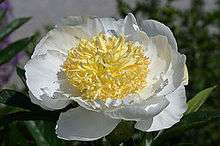Paeonia lactiflora
| Paeonia lactiflora | |
|---|---|
 | |
| Paeonia lactiflora | |
| Scientific classification | |
| Kingdom: | Plantae |
| (unranked): | Angiosperms |
| (unranked): | Eudicots |
| (unranked): | Core eudicots |
| Order: | Saxifragales |
| Family: | Paeoniaceae |
| Genus: | Paeonia |
| Species: | P. lactiflora |
| Binomial name | |
| Paeonia lactiflora Pall. | |
| Synonyms | |
Paeonia lactiflora (Chinese peony or common garden peony) is a species of herbaceous perennial flowering plant in the family Paeoniaceae, native to central and eastern Asia from eastern Tibet across northern China to eastern Siberia.
Description
It is 50–70 cm (20–28 in) tall and broad, with 9-lobed leaves 20–40 cm (8–16 in) long.
The flower buds appear in late spring (May in the Northern Hemisphere). They are large and round, opening into fragrant, cup- or bowl-shaped flowers 8–16 cm (3–6 in) in diameter, with 5-10 white, pink, or crimson petals and yellow stamens.[1]
Background
P. lactiflora was known as the white peony (P. albiflora) when first introduced into Europe.[2] It was brought to England in the mid-18th century, and is the parent of most modern varieties. There are several hundred selected cultivars in a range of colours, sizes and forms; many have double flowers, with the stamens modified into additional petals.[3] There are many colors now available, from pure milk white, to pink, rose, and near red, along with single to fully double forms. They are prolific bloomers, and have become the main source of peonies for the cut flower business.[2]
In China P. lactiflora is less highly valued as an ornamental plant than the cultivars of tree peony Paeonia rockii (tree peony) and Paeonia suffruticosa.
The following cultivars have gained the Royal Horticultural Society's Award of Garden Merit:-
- 'Bowl of Beauty'[4] [5] (double, pink & cream)
- 'Duchesse de Nemours'[6] (double white)
- 'Laura Dessert'[7] (double white)
- 'Sarah Bernhardt'[8] (double pink)
- 'Whitleyi Major'[9] (single white with prominent stamens)

Chemistry
The leaves of many cultivars are high in oleanolic and ursolic acid.[10]
Phenolic compounds
Cis-epsilon-viniferin, trans-resveratrol, trans-resveratrol-4'-O-beta-D-glucopyranoside, trans-epsilon-viniferin, gnetin H, and suffruticosol A, B[11] and paeoniflorin esters[12] can be found in P. lactiflora.
Petals color is dependent on a UDP-glucose: Flavonoid 5-O-glucosyltransferase expressing anthocyanins such as peonidin-3,5-di-O-glucoside, pelargonidin-3,5-di-O-glucoside, cyanidin-3,5-di-O-glucoside, peonidin-3-O-glucoside, cyanidin-3-O-glucoside, peonidin-3-O-glucoside-5-O-arabinoside, cyanidin-3-O-glucoside-5-O-galactoside and pelargonidin-3-O-glucoside-5-O-galactoside.[13]
Notes
- ↑ RHS A-Z encyclopedia of garden plants. United Kingdom: Dorling Kindersley. 2008. p. 1136. ISBN 1405332964.
- 1 2 Halda, Josef J.; Waddick, James W. (2004). The Genus Paeonia. Timber Press. pp. 196–205. ISBN 978-0-88192-612-5.
- ↑ Loewer, H. Peter (1999). Fragrant Gardens. Houghton Mifflin Gardening. p. 48. ISBN 978-0-395-88492-8.
- ↑ http://apps.rhs.org.uk/plantselector/plant?plantid=5543
- ↑ "RHS Plant Selector - Paeonia lactiflora 'Bowl of Beauty'". Retrieved 25 May 2013.
- ↑ "RHS Plant Selector - Paeonia lactiflora 'Duchesse de Nemours'". Retrieved 25 May 2013.
- ↑ "RHS Plant Selector - Paeonia lactiflora 'Laura Dessert'". Retrieved 25 May 2013.
- ↑ "RHS Plant Selector - Paeonia lactiflora 'Sarah Bernhardt'". Retrieved 25 May 2013.
- ↑ "RHS Plant Selector - Paeonia lactiflora 'Whitleyi Major'". Retrieved 25 May 2013.
- ↑ Zhou C, Zhang Y, Sheng Y, Zhao D, Lv S, Hu Y, Tao J.,"Herbaceous Peony (Paeonia lactiflora Pall.) as an Alternative Source of Oleanolic and Ursolic Acids." Int J Mol Sci. 2011;12(1):655-67
- ↑ Kim, H. J.; Chang, E. J.; Cho, S. H.; Chung, S. K.; Park, H. D.; Choi, S. W. (2002). "Antioxidative activity of resveratrol and its derivatives isolated from seeds of Paeonia lactiflora". Bioscience, Biotechnology, and Biochemistry. 66 (9): 1990–1993. doi:10.1271/bbb.66.1990. PMID 12400706.
- ↑ Yan, D.; Saito, K.; Ohmi, Y.; Fujie, N.; Ohtsuka, K. (2004). "Paeoniflorin, a novel heat shock protein–inducing compound". Cell Stress & Chaperones. 9 (4): 378–89. doi:10.1379/CSC-51R.1. PMC 1065277
 . PMID 15633296.
. PMID 15633296. - ↑ Isolation of a UDP-glucose: Flavonoid 5-O-glucosyltransferase gene and expression analysis of anthocyanin biosynthetic genes in herbaceous peony (Paeonia lactiflora Pall.). Da Qiu Zhao, Chen Xia Han, Jin Tao Ge and Jun Tao, Electronic Journal of Biotechnology, 15 November 2012, Volume 15, Number 6, doi:10.2225/vol15-issue6-fulltext-7
References
- PubMed abstracts: Palbinone, a novel terpenoid from Paeonia albiflora
- Plants for a Future: Paeonia lactiflora
External links
| Wikispecies has information related to: Paeonia lactiflora |
| Wikimedia Commons has media related to Paeonia lactiflora. |